- Home
- Deborah Harkness
The World of All Souls Page 12
The World of All Souls Read online
Page 12
Matthew was born in a small village in the Auvergne, which at the time was an important crossroads in medieval Europe. His lineage is French, from the mountain people who met up with invading Roman armies. Matthew learned his father’s trade of carpentry and was taught the new craft of stonemasonry that was arriving in the region from Italy. He was a craftsman and an artist long before he was a scientist, and this is an important part of his personality.
Matthew is a deeply flawed hero. He has several vulnerabilities: rage, arrogance, and a continuing quest for redemption and forgiveness. At the same time, Matthew is a gifted healer, a gentle man who yearns to be a father. As a scholar he has seen countless theories overturned and numerous brilliant minds judged for their shortcomings. Yet still he strives for truth and order in the world around him. He loves music, art, and poetry. Like his faith and his science, these have provided a harbor for him in the storm of life. Over the centuries he has developed a finely tuned radar for quality of mind and talent. As with all other aspects of his life, Matthew does not blindly follow trends but recognizes quality when he sees it.
Matthew’s way of being in the world is as complex as the man himself. He can seem both highly traditional and conservative yet also willing to change. So Matthew will use an eighty-year-old fountain pen, lovingly restored and tended to keep it in working order, but also buy the latest laptop the moment it’s released. Matthew surrounds himself with items that are beautiful and functional. When he finds something that works for him, he sticks to it, whether it’s a model of car, a brand of pen, a style of shoe, or a daily ritual. There is no change for change’s sake.
For all his many gifts—good looks, talent, intellect, physical strength—Matthew always feels like the black sheep. He is a loner, an outcast. He is the de Clermonts’ hidden weapon, and his blood rage is their deeply held family secret. If that were discovered, it would mean death not only to him but to his maker, Ysabeau, and his children as well. His family has used Matthew’s shameful blood rage to their advantage, forcing him to occupy the position of the de Clermont family assassin. He has done the distasteful job with distinction and his own peculiar brand of honor, but it has taken a terrible toll on him in many ways, not least of which is marginalization.
Living on the margins has made Matthew an expert watcher. Whether in scientific observation or pursuing a woman who interests him, his single-mindedness can blind him to possible conflict and danger. He can be impulsive but is deliberate in his actions, too, and will watch and wait far longer than others would—human or vampire. He is the consummate hunter, biding his time until the perfect moment to pounce on his prey.
Matthew’s salvation is his abiding Catholic faith and his desire to understand the world around him and his place in it. Over the centuries, these two avenues—the religious and the scientific—have formed the lifeline to bring him out of the darkness of his guilt and family expectations. Now, having Diana and a family of his own provides another.
PHILIPPE DE CLERMONT
Full name and other names: Philippe de Clermont, Alcides Leontothymos (the birth name attributed to Heracles)
Origin of name: Philippe is the French variation of Philip, which has origins in Ancient Greece. A literal meaning from the Greek elements means “lover of horses” and in turn (with horses owned only by the rich and powerful) “noble.” De Clermont is a place-name from France, made up of the old French clair or cler, meaning “clear,” and mont, “a hill.”
Date of birth: Unknown
Date of rebirth: Unknown
Physical description: Philippe looked like the lion he was, with tawny hair, sun-kissed skin, and hazel eyes that sparked with life and intelligence.
A member of: The Congregation, the Knights of Lazarus
Family and romantic relationships: Philippe’s birth parents and vampire sire are unknown. He was lover and devoted mate of Ysabeau de Clermont, and together they ruled and nurtured their brood of de Clermont vampire children. His blood sons include Hugh, Baldwin, and Godfrey, and daughters Freyja, Verin, and Stasia, as well as stepson Matthew de Clermont and blood-sworn daughter Diana Bishop.
Personal history: Philippe, the patriarchal sire of the de Clermont clan, is the absent presence at the heart of A Discovery of Witches. He is the soul of the story, the keeper of secrets, the warrior of human myth and legend, the romantic hero on whom all subsequent heroes have been based. His origins lie so far back that no one—not even ancient vampires like Ysabeau and Marthe—know for sure how or when he was made. By the time of the ancient Vampire Wars—and those took place millennia ago—Philippe was already a battle-scarred and tested warrior.
Philippe was a man whose personality and physique matched the greatness of his spirit and courage. Though not human, he was one of the most humane men who ever lived. Difference did not frighten him, and his views of the world were expansive, accepting, and tolerant. One of the reasons Philippe lived as long as he did was his firm conviction that in order to survive one had to be willing to change. He was the most adaptable of vampires, never fighting against the prevailing winds but sailing along with them to his next home, his next adventure, his next challenge.
The one fixed point in Philippe’s life was his mate, Ysabeau. Once they’d met, there was never anyone else for him. She was the center of his world, the axletree of his universe. Philippe would have destroyed anything and anyone who threatened her, including his own children. To outsiders Philippe seemed to overindulge his mate, allowing her freedoms and privileges that most vampire patriarchs would never permit. But he knew that Ysabeau was fragile and that having once been a prisoner she would never survive in captivity, no matter how gilded the cage.
Philippe’s great disappointment in life was that he did not manage to create a safe haven for creatures in the Holy Land. This project was dear to his heart for centuries. When he had to face the inescapable truth that such a promised land was not meant to be, he behaved as he always did when confronted with obstacles: He regrouped and launched an entirely new venture called the Knights of Lazarus.
Tragically, Philippe died as a result of injuries sustained in the death camps of Nazi Germany in World War II. In a mission to free Allied female spies, he was captured and subjected to medical experiments and torture. The Nazis were fascinated with the question of how much damage a vampire’s body could sustain without dying. In fact, it was Matthew’s vampire son Benjamin who performed the torture as personal revenge against the de Clermonts. To ensure that Benjamin did not discover any damaging family secrets, Philippe sought the help of a witch imprisoned in the camps. She muddled Philippe’s mind, took his memories, and left behind nothing but a chaos of fragments. Though Matthew and Baldwin were able to rescue Philippe from the camps, there was no way to heal his broken mind. After Philippe’s repeated attempts to end his own life, Matthew and Ysabeau finally agreed to help him. Matthew drank his blood dry, taking in the images of his life and sharing the agony of his final torture. Philippe’s last thoughts, and the only memories still left whole, were of his beloved Ysabeau.
VERIN DE CLERMONT
Origin of name: Verin is of Slavic origin, meaning “faith.”
Date of birth: Unknown
Date of rebirth: Unknown
Physical description: Verin has the smooth and serene face of a woman in her twenties. Her posture is easy, and her black hair and silver-gray eyes sparkle with energy and intelligence. Despite her elfin quality, she often has a knife concealed in her high-heeled boots.
A member of: The Knights of Lazarus
Family and romantic relationships: One of Philippe de Clermont’s formidable daughters and mated with a human, Ernst Neumann. She and her nephew Gallowglass are close.
Personal history: Verin is as strong as her sisters, Stasia and Freyja (the family eventually begged Philippe to stop making daughters, because they were so terrifying). Verin lives in Berlin with her husband, E
rnst, whom she married when he was twenty-five. They met when Ernst was a boy at the end of World War II, and she saved him from her stepmother, Ysabeau, who went on a grief-stricken rampage through Germany following Philippe’s death. Ernst is now approaching retirement, and they are as devoted to each other as ever.
Verin, despite her reluctance to receive a witch into the family, was the one who acknowledged Philippe’s blood vow to Diana and confirmed her place in their family.
YSABEAU DE CLERMONT
Full name and other names: Genevieve Mélisande Hélène Ysabeau Aude de Clermont, Mélisande
Origin of name: Ysabeau is another form of Isabel and means “God’s promise”
Date of birth: September 17, very long ago
Astrological birth sign: Virgo
Date of rebirth: Unknown
Physical description: Ysabeau is a classic beauty, with blond hair, green eyes, pale skin, and a shapely figure. She is petite, though not as small as Miriam. The impression she gives is one of grace and delicacy. Ysabeau is the personification of French style, favoring a monochromatic palette of fawn, beige, and cream. Her hair is long and usually worn in a French twist. Her footwear varies between high heels and riding boots. She prefers French designers (naturally), classic lines, and expensive fabrics.
Family and romantic relationships: Ysabeau is the lover and mate of vampire Philippe de Clermont, matriarch of the sprawling de Clermont clan, and mother to Matthew de Clermont as well as Louisa and her twin brother, Louis. Her maker was a fearsome vampire of antiquity.
Personal history: Ysabeau de Clermont is one of the oldest vampires in existence—and the cleverest. Known for her beauty and elegance, Ysabeau was mated to the legendary Philippe de Clermont, and together they became the de facto rulers of European vampire culture. Though others tried to unseat them, the two survived centuries of war and politics. Philippe always credited their success to Ysabeau’s cunning and ruthlessness, calling her “my general.”
Ysabeau is a miracle of survival. She was made a vampire against her will, and her early years after rebirth were filled with rape, torture, and torment at the hands of her maker, who had blood rage. When Philippe freed her from captivity, she was feral. It took centuries for Ysabeau to recover and to trust again. Because of her experiences, Ysabeau can seem icy and forbidding, but this is a façade. At her core Ysabeau is a blend of courage and wounds that will never fully heal.
Though Ysabeau has never exhibited any signs of blood rage, she is a carrier of the disease. Some of her children—namely, Matthew and Louisa—do have full-blown blood rage, though most do not. Because of the perception among vampires that this is a curse, the family has kept Matthew’s and Louisa’s condition a secret. Philippe knew that if it was revealed, not only would their lives be forfeit, but so would Ysabeau’s—and he would prevent that no matter what the cost.
Like Philippe, Ysabeau is an avid reader of newspapers, romance novels, and adventure stories. She loves going to the movies and adores escapist fare like romantic comedy and epic fantasy. Her taste in furniture and art is impeccable, and she has been a patron of important painters, sculptors, and craftsmen over the centuries.
In spite of her delicate appearance Ysabeau is capable of acts of great ruthlessness. She is fiercely protective of her children and will do whatever it takes to keep them from harm. Philippe’s death following Nazi torture almost drove Ysabeau mad with grief, and in the period immediately afterward she would hunt only in Germany and Argentina. She held a deep hatred for witches due to her belief that they were involved in Philippe’s torture. But she gradually learned to live again and keep the de Clermont clan together without him, despite the divisions among their children. She always has the calm and devoted Marthe by her side at Sept-Tours to support her.
MARJORIE COOPER
Marjorie Cooper, short, with a round face, was an earthwitch and a member of the St. James Garlickhythe gathering in sixteenth-century London. She was married to a vintner. Her magical specialty was remembering, and she coached Diana in finding the right words for her spells and, in turn, how to imprint them on her memory.
AMEN CORNER
A member of Andrew Hubbard’s family in London, Amen Corner is an angular young man with a strangely fitting name, taken from the place in the church where he was discovered as a foundling. He is part of the gang with Leonard Shoreditch with whom Jack Blackfriars hangs around.
PIERRE CORNU
Pierre is another devoted, loyal vampire servant in Matthew’s extensive entourage and was at the Old Lodge on Matthew and Diana’s arrival in 1590. He is a slender man who has an expressive face, weather-beaten skin the color of hazelnut, and black hair and eyes. Pierre especially took a shine to Jack and Annie, helping look after them in sixteenth-century London.
CORRA
Corra is Diana’s familiar, a firedrake. A firedrake looks like a dragon with two legs and is a union of opposites: a creature of both fire and water. As one might expect of a Bishop familiar, Corra is extremely difficult to handle. Gallowglass calls her “wee beastie,” “demented parakeet,” and occasionally worse.
See also: MAGIC: Familiars
LINDA CROSBY
Linda, a neatly dressed elderly woman, is a witch in modern-day London, in the area where Diana and Matthew lived in 1590. She is a member of Andrew Hubbard’s family and a descendant of earthwitch Marjorie Cooper, whom Diana met in the sixteenth century. Linda helped Diana weave the spell to locate the owner of the third missing page from the Book of Life.
D
MR. DANFORTH
A clergyman in sixteenth-century Woodstock, Mr. Danforth was a fearful man, a bit unkempt and not particularly bright. He had some education, having attended university, and had read at least some part of the witch-hunting manual Malleus Maleficarum. Eager to wield it against those he suspected of witchcraft, Danforth soon had Diana Bishop in his sights. He petitioned his bishop to have Diana investigated by London authorities, but Matthew and Diana were able to put a stop to the inquiry by appearing privately before Elizabeth I.
JANE DEE
Origin of name: Jane is derived from the Old French Jehanne and is the feminine version of the name Johannes or John.
Date of birth: 1555
Physical description: Diana encountered a sharp-faced, ample-hipped woman, many of whose gowns had seen better days.
Family and romantic relationships: Born Jane Fromond, she became John Dee’s disgruntled wife and mother to eight children.
Personal history: The much younger wife of the alchemist John Dee, Jane had previously been lady-in-waiting to Elizabeth Clinton, the Countess of Lincoln, in Queen Elizabeth’s court. After her marriage Jane lived with her husband and their children in the small village of Mortlake, on the river Thames west of London; they also spent years living abroad. Even by sixteenth-century standards, the Dee household was large and tumultuous. Jane, who reportedly had a sharp tongue and a forthright manner, cared for their many children and oversaw numerous domestic servants, including one who infamously jumped down the well; conditions within the Dees’ home were not for the fainthearted.
In order to support her husband’s scientific work, Jane needed to feed a constant parade of visitors. Less frequently, though more happily, she also entertained his sponsors. Her efforts were made more difficult by the irregular nature of Dee’s income, depending as it did on the fickle favor of wealthy patrons such as Her Majesty Queen Elizabeth I, the Marchioness of Northampton (of the silver salt), and Sir Philip and Lady Mary Sidney. Visits from the queen’s representatives were most welcome, however, even if they were vampires and especially when they came bearing gifts.
Jane also had to share her home with her husband’s scientific apprentices. She had a particularly complicated relationship with Dee’s most favored assistant, the unstable Edward Kelley. Kelley was known to leer openly at her in public and other
wise displayed an unsettling interest in her person. In 1587, only a few years before Diana met Dr. Dee and his wife in Mortlake, Edward Kelley claimed to have received a message from a spirit, instructing Kelley and Dee to share everything they had, including their wives. According to Dee’s account of this revelation, he and Kelley were stunned by the news and their wives took it very hard as well. We do not know Joanna’s response, but according to Dee’s diaries Jane “fell a-weeping and trembling for a quarter of an hour,” although at length she agreed, saying, “I trust, though I give myself thus to be used, that God will turn me into a stone before He would suffer me, in my obedience, to receive any shame or inconvenience.” It seems all four of them did follow the spirit’s orders. Soon thereafter the Dees left Prague and returned to Mortlake, where, nine months later, Jane had a son, whom they christened Theodorus Trebonianus. His name means “the gift of God at Trebon.” (Trebon is the town near Prague where Dee and Kelley had settled.) The Dees never saw the Kelleys again, and this cross-matching was not discovered until Dee’s journals were read after his death.
See also: John Dee, Edward Kelley, Joanna Kelley
DR. JOHN DEE
Origin of name: Dee is derived from the Welsh du, meaning black.

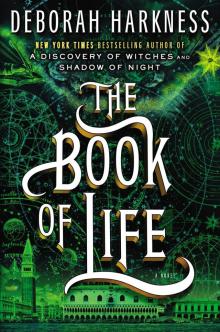 The Book of Life
The Book of Life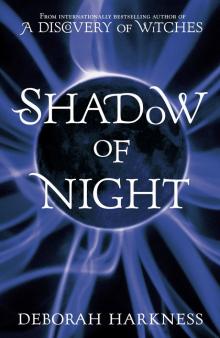 Shadow of Night
Shadow of Night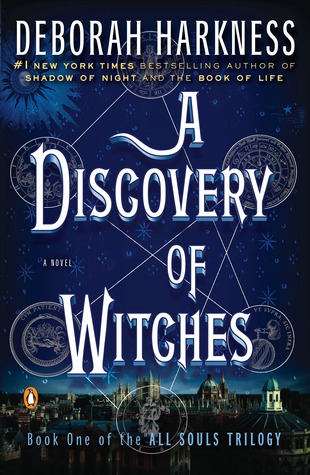 A Discovery of Witches
A Discovery of Witches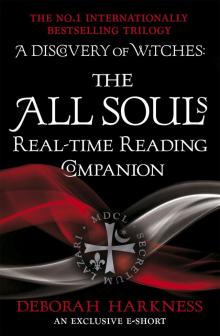 The All Souls Real-Time Reading Companion
The All Souls Real-Time Reading Companion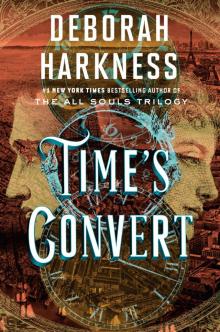 Time's Convert
Time's Convert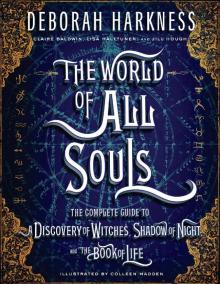 The World of All Souls
The World of All Souls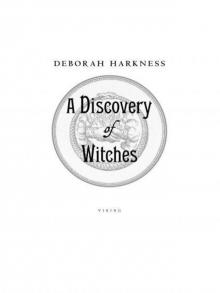 A Discovery of Witches: A Novel (All Souls Trilogy)
A Discovery of Witches: A Novel (All Souls Trilogy) Shadow of Night: A Novel
Shadow of Night: A Novel